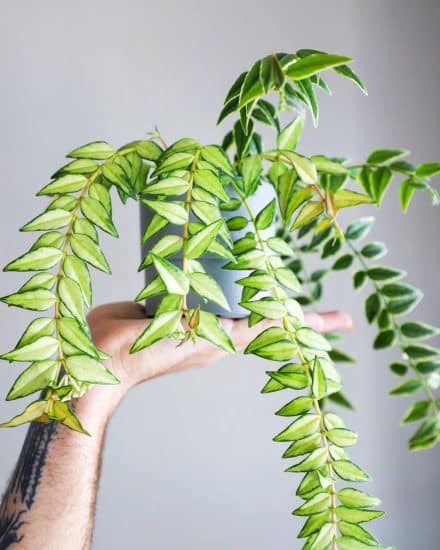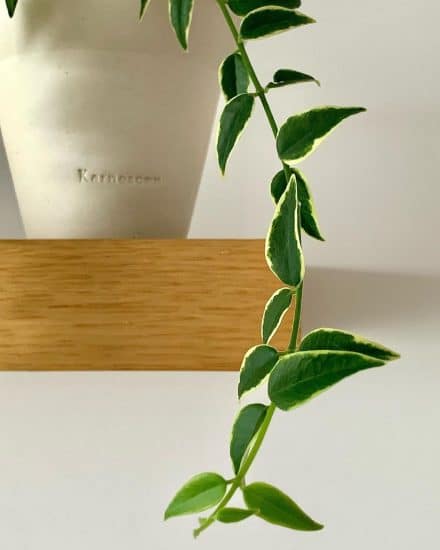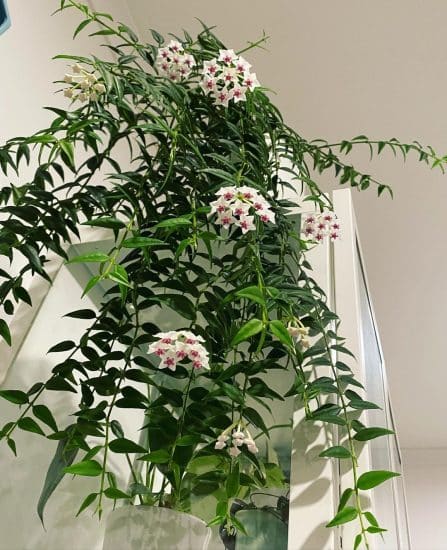Hoya Bella is one of the most popular hoya plants around.
And it’s no wonder — with those dark green leaves, unique trailing growth habit, and vibrant, star-shaped flowers, how could anyone resist?
Let’s get into the nitty-gritty of Hoya Bella care, from providing the perfect lighting and watering conditions to mastering the art of propagation. Plus, we’ll get into the best ways to keep your plant free from pests and diseases.
Table of Contents
Hoya Bella Plant Care Guide
History, Habitat, and Characteristics

Hoya Bella (Hoya bella or Hoya lanceolata ssp bella) is a tropical plant that originates in the tropical rain forests of Southeast Asia, namely Myanmar and the Indian state of Assam. It’s a medium to fast grower with dark green leaves and a unique trailing growth habit, making it perfect for hanging baskets.
Because Hoya Bella exhibits a trailing habit, this evergreen plant is also an excellent climbing plant. You can use a trellis or other support to encourage it to climb, and after a while, it may reward you with the next great feature of Hoya Bella plants.
Hoya Bella is also known as the miniature wax plant, and like its cousin Hoya carnosa, this Hoya species displays star-shaped flowers that come in shades of pink or white . . . and let’s not forget that delightful fragrance. The fragrance of Hoya Bella’s flowers is so sweet, it’s even been called the honey plant.
Light

Bright indirect sun is the sweet spot for Hoya Bellas. For best results, place your plant in a south- or west-facing window. Hoya plants can tolerate some medium light, but they may become leggy and fail to flower without sufficient exposure to sun.
But don’t overdo it! You may find an east-facing window isn’t enough but a south one is too much. Play around with it to find what works.
If you do place your Hoya in direct sun, make sure it’s only in the morning or early evening, never during the hottest part of the day. However, the variegated variety (which is a bit harder to come by) can actually handle more light than their all-green siblings.
If your Hoya Bella grows slowly, produces few leaves or flowers, or gets leggy, it needs more light. Move it to a brighter spot or use an artificial light source, like a grow light, to make sure it’s getting enough bright indirect light.
But if your Hoya Bella is getting too much light, you may notice discolored or scorched leaves. Either move the plant further from the window or put up a sheer curtain to filter some of that intense sunlight.
Lighting tips:
- Place your hoya in indirect bright light, like a west-facing window.
- Avoid direct sun during the hottest part of the day.
- Use a sheer curtain to diffuse harsh afternoon sun.
- Use a grow light to encourage healthy growth in insufficient light.
Water

Hoya plants will not react well to soggy soil. It’s best to let at least the top 2 inches dry out before watering. Water thoroughly, allowing the water to drain from the bottom of the pot. You’ll water more or less depending on how much light your plant is getting.
Here’s a nifty trick to know when your Hoya Bella prefers a drink: Gently give a leaf a little squeeze. If the leaf bends easily or kinda “tacos,” it’s a sign that it’s thirsty.
Also keep an eye out for soft and wrinkled leaves, which might mean it’s not getting enough water. Be sure to consistently feel the soil to tell how dry or wet it is.
Consistently wet soil will spell trouble for your hoya. Yellowing leaves and a droopy plant are all signs that you’re overwatering. If you think you’re giving your Hoya Bella too much water, adjust your watering routine and make sure it has proper drainage.
Like most houseplants, you’ll find that Hoya Bella plants need less water in winter than they do in summer. During the colder months, it’s okay to let your hoya’s soil dry out completely between watering, but don’t leave it too long. If the soil starts to separate from the sides of the pot, your plant needs water.
Watering tips:
- Allow the top 2 inches of soil to dry out.
- Avoid consistently soggy soil.
- Ensure proper drainage.
- Reduce watering in winter.
Temperature and Humidity

Hoya Bella is a tropical plant, and as such, it prefers warm indoor temperatures of 65°F-80°F (18°C-27°C). It’s essential to avoid extreme heat or cold because they do not tolerate such conditions well.
During the summer, Hoya Bellas can thrive in moderate temperatures, but be mindful of their placement within your home and avoid direct sun and exposure to air conditioning vents.
In winter, keep them away from windows and doors that might expose them to temperature extremes, as well as heating vents, which could cause stress to the plant.
When it comes to humidity, aim for an average air humidity of 40%-50%. If you notice the leaves becoming wrinkled, the humidity level is too low. On the other hand, yellowing leaves or mold issues might indicate excessive humidity.
To increase humidity:
- Place your potted plant on a pebble tray filled with water, but don’t let it sit in standing water.
- Run a humidifier near your plant for a few hours each day.
- Place your plant in a naturally humid room, like a kitchen, as long as there’s enough light.
Soil and Planting

Your miniature wax plant needs a well-draining, rich potting mix for healthy roots and proper aeration. The ideal combination includes a high-quality potting soil, as well as coconut coir (an eco-friendly alternative to peat moss), perlite, and worm castings.
If you grow Hoya Bella in the wrong potting soil, it can lead to various issues. Signs of poor soil include yellowing or wilting leaves, slow growth, and weak stems. These issues might arise from a lack of aeration, leading to reduced oxygen availability for the roots, or improper drainage.
Of course, these symptoms may also be a sign that it’s time for repotting Hoya Bella. Gently remove the plant from its pot and inspect the roots. If you see a lot of visible roots on the outside of the soil, it needs repotting. It’s best to do this when your plant isn’t blooming. Since the miniature wax plant blooms from May to August, repot in early spring.
When repotting, choose a pot that’s only a few inches taller and wider, with one or more drainage holes. Using the prescribed Hoya Bella soil combination, repot your plant, give it a gentle watering, and see its health begin to thrive again.
Fertilizer
Hoya Bella plants really benefit from regular fertilization. They’ll flower more easily and grow a bit faster. You’ll want to use a balanced liquid fertilizer, diluted to around 50% strength. You can apply this every month or two while you see growth, or at even greater dilution more frequently when you water.
Over-fertilizing your Hoya Bella can lead to a number of symptoms, such as leaf burn, yellowing foliage, and stunted growth. If you notice these signs, it’s essential to address the issue promptly.
First, reduce the frequency of fertilization or the concentration of the fertilizer. Next, flush the excess fertilizer by watering the plant with plain water until it drains freely from the bottom of the pot.
To prevent over-fertilization, be sure to follow the product’s instructions, and avoid fertilizing in winter, when the plant needs fewer nutrients.
Propagation Guide

You have several options when it comes to Hoya Bella propagation. Let us introduce you to some foolproof propagation methods using cuttings in soil, water, and an alternative coconut husk chip strategy.
Propagating Hoya Bella by stem cuttings in soil:
- Snip a healthy stem cutting from your Hoya Bella plant, making sure it has at least one or two leaf nodes (where the leaves attach to the stem).
- Pop the cutting into a pot filled with a general-purpose potting mix. Ensure that the mix isn’t too compact for proper root development. Bury the bottom node or nodes in the soil, making sure at least one node is covered.
- Give your cutting some water every 3 to 4 days, keeping the soil consistently moist but not soggy. Place the pot somewhere with indirect sunlight, and keep an eye out for new growth.
Propagating by stem cuttings in water:
- Take a healthy stem cutting from your Hoya Bella plant, ensuring it has at least one or two leaf nodes.
- Set the cutting in a small, clear vessel filled with water and place it in indirect light. The nodes should be submerged in water, but keep the leaves above the surface.
- Watch for root development. Refresh the water every few days to keep it fresh. Once you notice healthy roots about an inch long, it’s time to move the cutting to soil.
Propagating by stem cuttings in coconut chips:
- Clip a healthy stem cutting from your Hoya Bella plant, with at least one or two leaf nodes.
- Nestle the cutting in a pot with coconut husk chips, covering the node or nodes. Coconut husk chips create an airy environment for roots to grow, resembling Hoya bella’s natural epiphytic growing conditions.
- Shower the cutting with water regularly to maintain consistently moist coconut husk chips. Position the pot in indirect light and look out for new growth as the cutting finds its footing.
Our propagation tips:
- Your stem cuttings should have at least one or two healthy leaves for the best shot at successful propagation.
- Dodge direct sun during propagation because it can dry out or scorch the cutting.
- Patience is key! It may take a few weeks for roots to form, and different methods might work better for different people. If your first try doesn’t go as planned, don’t worry — you’re still learning!
- The growing season is the prime time for propagating Hoya Bella. So pick a sunny day and get to propagating!
Common Issues

Wrinkling Leaves and Leaf Drop
It’s likely due to something as simple as watering — either too much or too little water for your Hoya Bella. Insufficient drainage can also be the culprit. To crack this case, check the moisture levels in the soil and check your pot has proper drainage holes.
Now, let’s fix this issue. To keep your Hoya Bella healthy, make sure the soil is consistently moist (but not drenched!), and provide the right drainage.
Water your plant when the top inch or two of soil feels dry, and be ready to tweak your watering schedule as needed. Just like that, you’ll stop the overwatering or underwatering problem in its tracks!
Slow Growth
The usual suspects for slow growth are insufficient light, a watering routine gone awry, or a lack of nutrients. Take a look at your plant’s environment — is it getting bright, indirect light without being thrown into the harsh glare of direct sunlight? If not, try placing it in dappled shade or partial shade.
Next, double-check your watering habits, ensuring that you’re providing consistent moisture without turning the soil into a swamp.
During the growing season, treat your Hoya Bella to a well-balanced fertilizer every 4 to 6 weeks. If you’ve tried all of this and your plant is still lagging behind, it might be time to move it to a new home. Repot your Hoya Bella into fresh, high-quality potting soil, and watch it flourish!
Pests and Diseases

Mealybugs and Spider Mites
Mealybugs are easy to spot by the white, sticky mess they leave on branches and leaves. To treat a mealybug problem, you’ll want to first wipe off as much as you can with a delicate cloth.
Then, spray your plant with some neem oil or insecticidal soap, making sure to pay close attention to the underside of the leaves, where these buggers love to hide.
You might also want to watch out for spider mites, another common pest that can infest your Hoya Bella. Treating spider mites is similar to mealybugs. It involves wiping off as many pests as you can (and their webbing) and using a homemade mixture of water and liquid soap or neem oil, which can effectively eliminate them.
When it comes to keeping pests off your plants, prevention is key. Keep an eye on your Hoya Bella and check it regularly for any signs of unwanted visitors. Regularly give the leaves a gentle wipe with a damp cloth to remove dust and check for infestations.
Fungus Gnats
Fungus gnats are a common problem among houseplant collectors. They usually happen in conjunction with overwatering, so the key to preventing them is to avoid overwatering your plants.
Fungus gnats breed in your plant’s soil, where the larvae feed on the roots. This can eventually damage your plant. Use sticky traps to trap the adults, and swap out the top 2 or 3 inches of soil with fresh soil. For stubborn infestations of fungus gnats, repot your hoya plant in completely fresh soil.
Root Rot
This issue usually happens to indoor plants that get too much water or don’t drain well enough, creating a soggy environment where harmful bacteria can party on your plant’s roots.
If you notice yellow leaves, a wilted appearance, constantly wet soil, and a rotten odor coming from your plant, it’s undoubtedly root rot. When you take the plant out of the soil, the roots will look brown or black and mushy. You’ll need to take swift action to save your hoya plant.
First, remove your Hoya Bella from its pot and snip away any bad-looking roots with sterilized scissors. Next, repot the plant into fresh soil that has great drainage. You can enhance the soil by adding some perlite, pumice, or LECA.
Finally, remember that the key to avoiding root rot is to let the soil dry out between waterings — and to always have a drainage hole.
Conclusion

That’s a wrap for our Hoya Bella care guide! You now have all the information you need to add Hoya Bella to your hoya plant collection. Just remember to provide the right balance of light, water, temperature, and humidity, and your plant will reward you with its cascading vines and aromatic blooms.
Hoya Bella care summary:
- Place your Hoya Bella in a well-lit area with bright indirect sunlight
- Avoid direct sunlight, which can scorch its leaves.
- Maintain moist soil by watering your plant when the top 2 inches are dry.
- Keep indoor temperatures between 65°F-80°F (18°C-27°C) and aim for a humidity level of 40%-50%.
- Use a well-draining, rich potting mix and remember to fertilize your plant during the growing season.
We hope this guide has been helpful and inspires you to create the perfect home for your Hoya Bella. If you have any questions or concerns, please don’t hesitate to reach out.
And if you found this guide useful, feel free to share it with other plant lovers!
Happy growing!
FAQ
Is Hoya Bella easy to grow?
Hoya Bella care is a breeze! All it takes is the right balance of light, water, temperature, and humidity to keep them happy and healthy.
How long does it take for Hoya Bella to bloom?
Patience is key with Hoya Bella! Generally, it can take anywhere from 2 to 3 years for a Hoya Bella plant to bloom, but sometimes they’ll surprise you and bloom earlier than expected. Blooming typically occurs during the warmer months, and once it starts, it can last for several weeks.
To encourage blooming, make sure your plant is getting the right mix of indirect sunlight, proper watering, and balanced fertilization.


